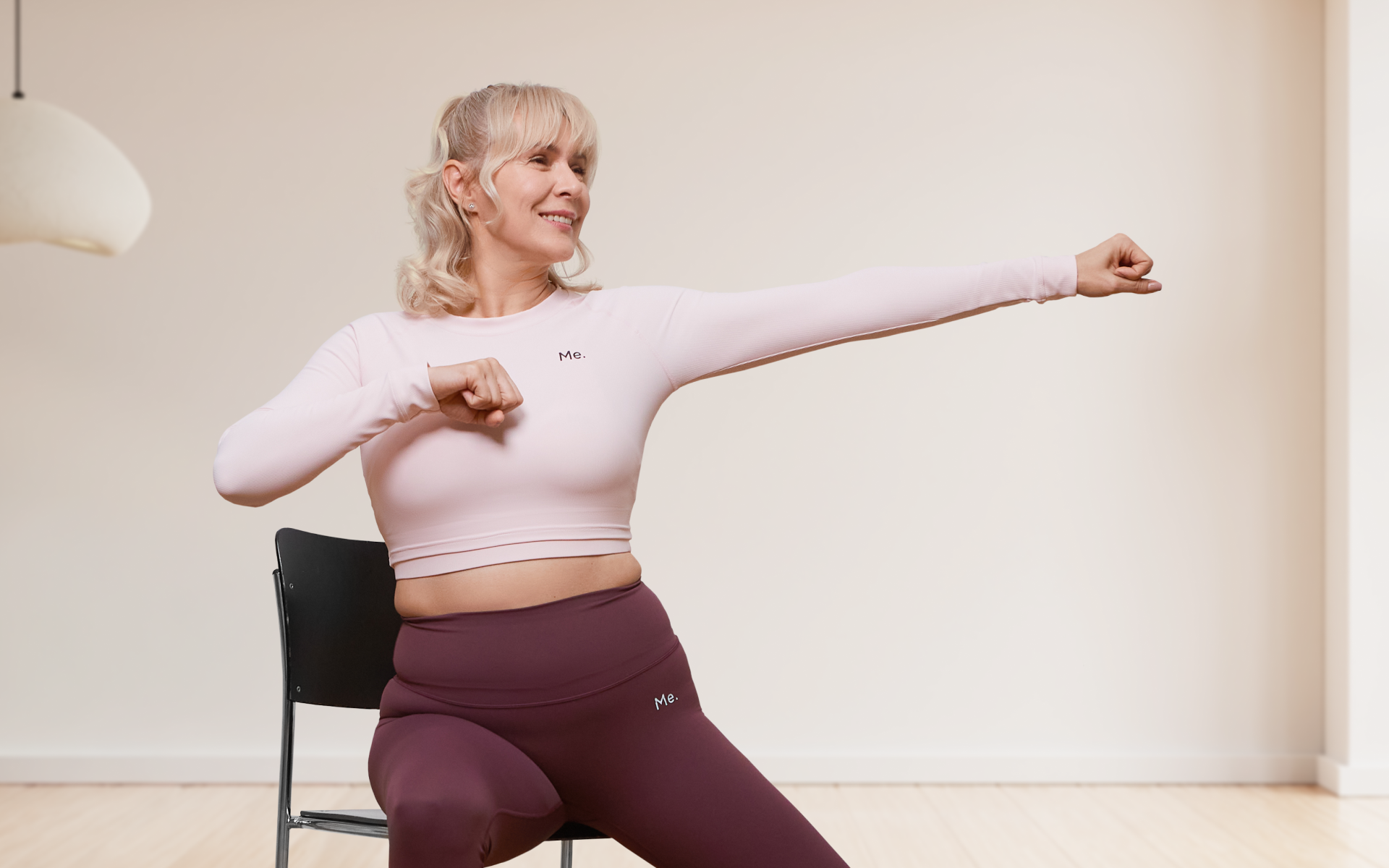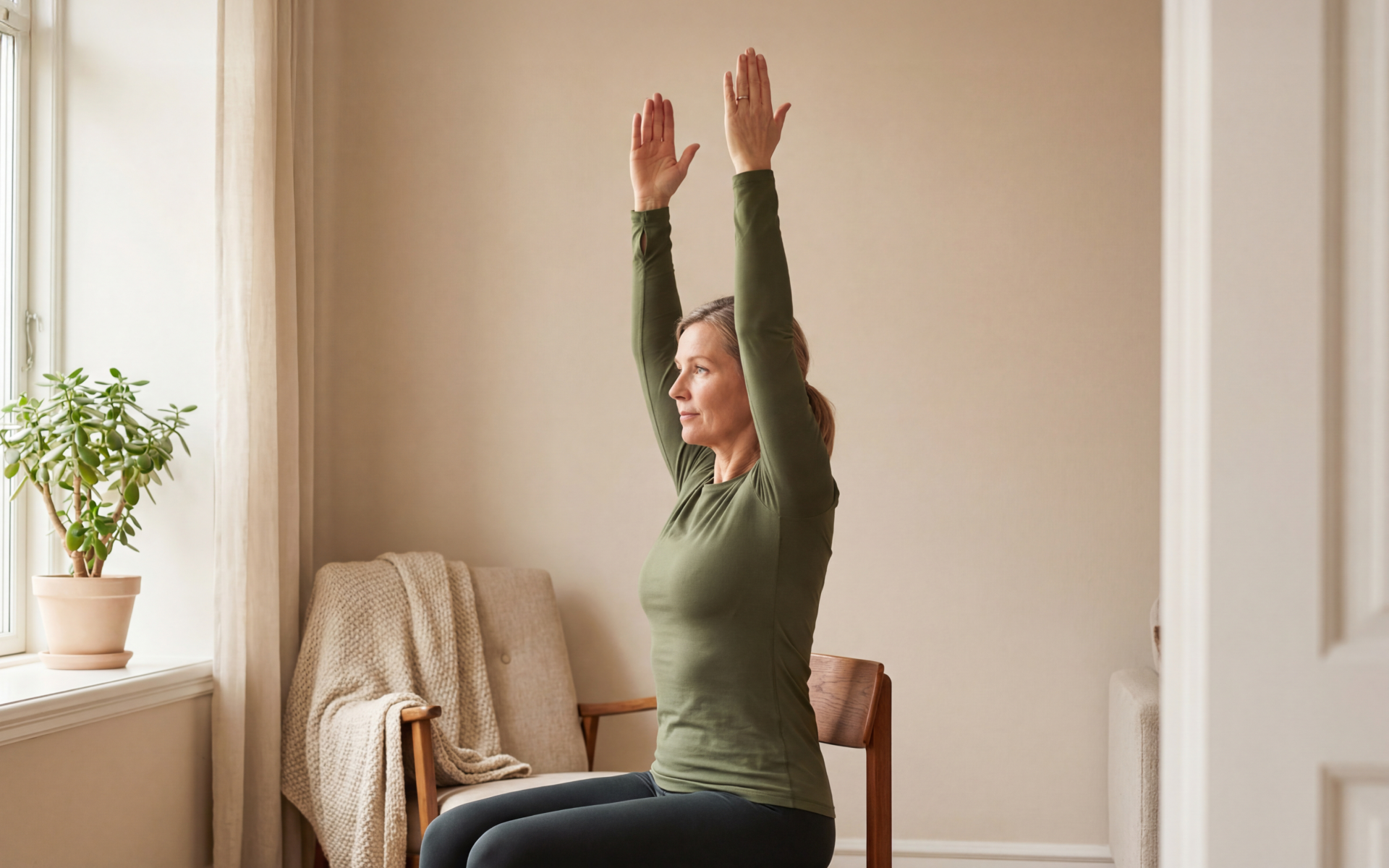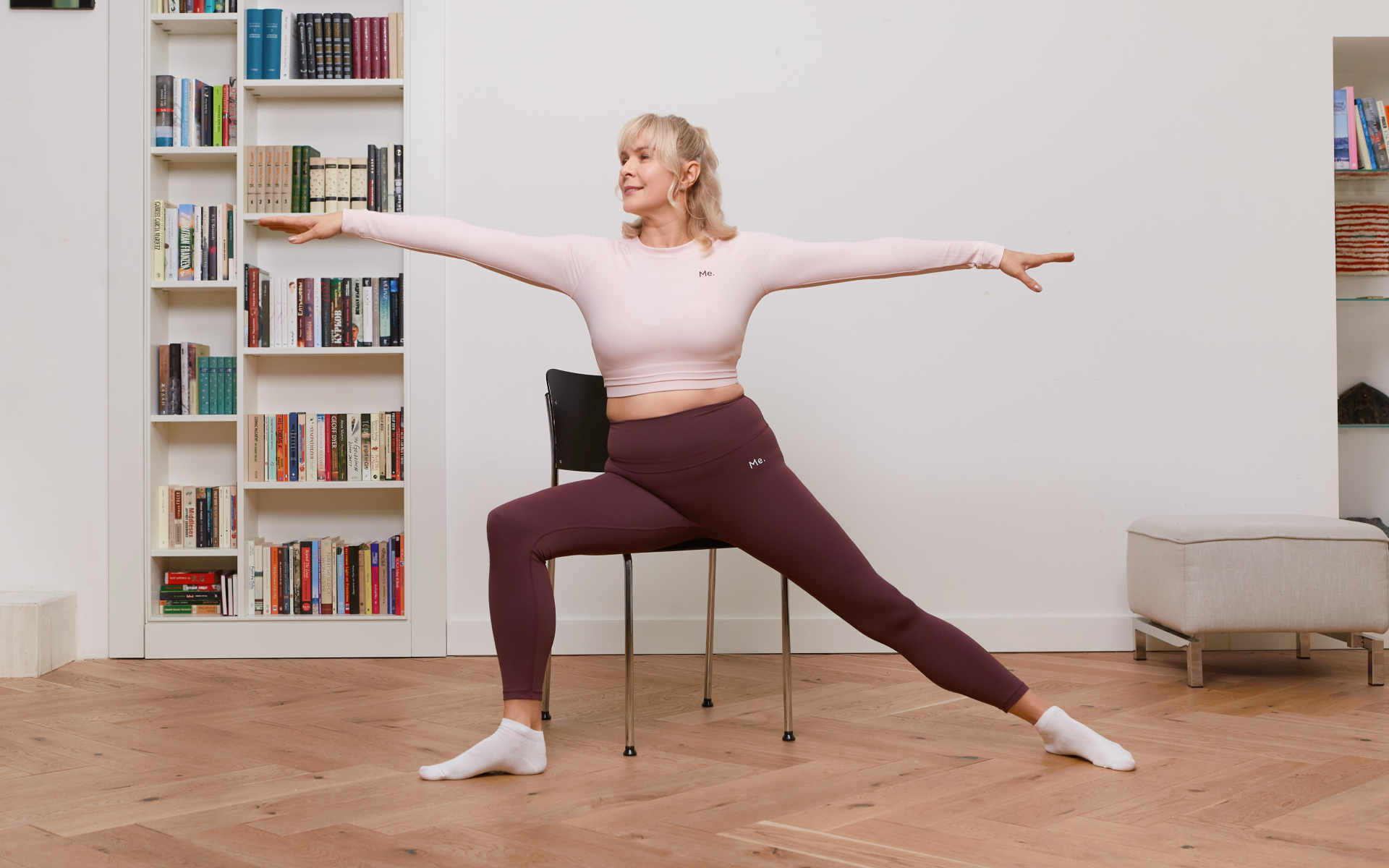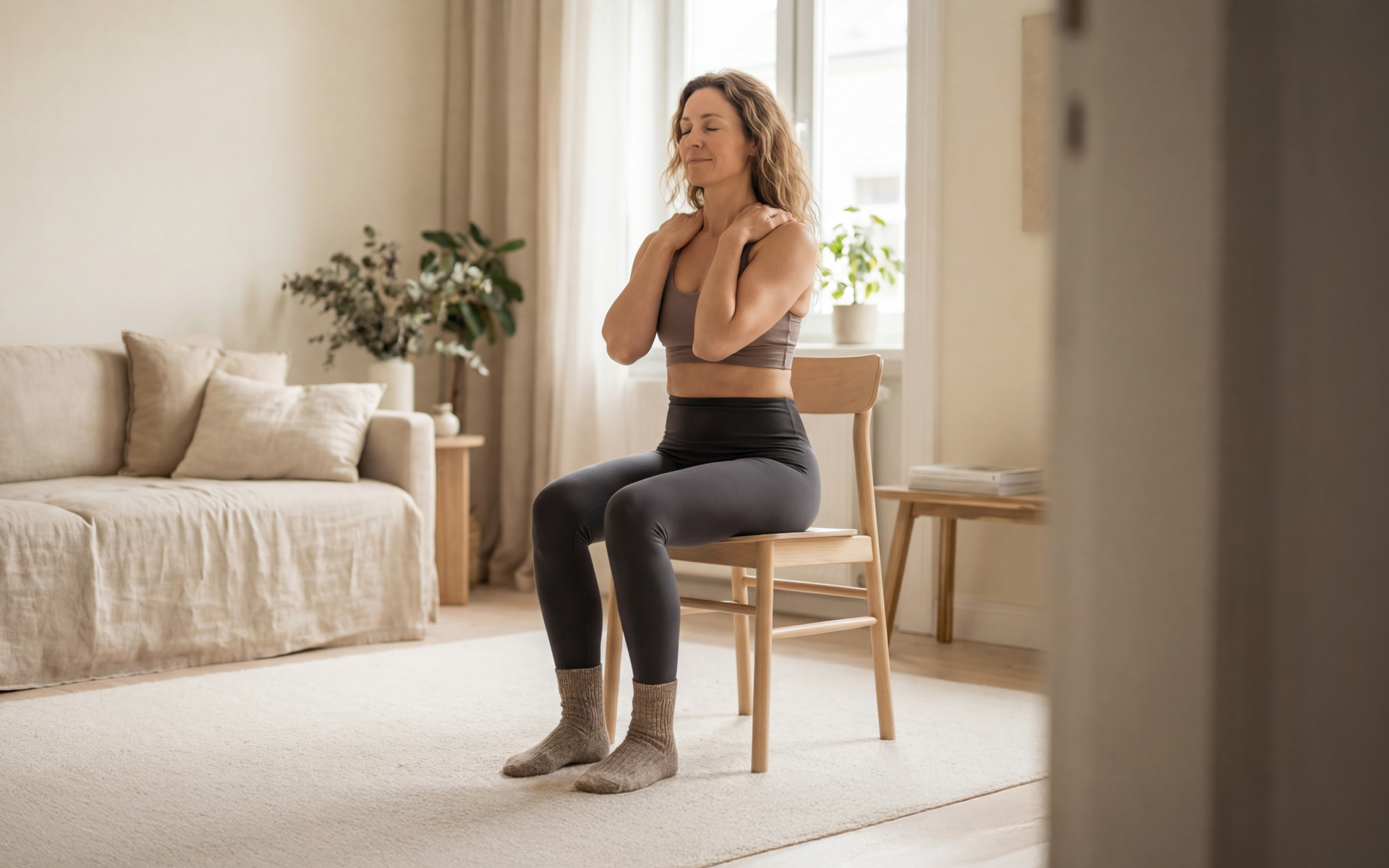A chair workout might seem like a low-intensity exercise routine, but it can actually be an effective way to stay fit and healthy. For those who have mobility issues or are recovering from an injury, it allows for a gentle yet thorough workout.
Those who spend long hours at a desk can benefit greatly from these exercises. Both beginners and the elderly will find it approachable.
You don’t have to sit the entire time. The standing exercises while using the chair for support can significantly improve balance and strength.
Here’s a list of ten chair workout exercises that can help you achieve a full-body workout:
Are Chair Workouts Legit?
Chair workout exercises are designed to provide a full-body workout by using only a chair. It’s a great way to target specific muscle groups while improving balance, stability and flexibility. These exercises can be modified based on your fitness level, making it suitable for beginners or those with mobility limitations.
Additionally, they can help improve posture and reduce the risk of muscle imbalances that may occur from prolonged sitting.
Below are some chair workout exercises that target different muscle groups:
1. Chair Squats (Major: Quadriceps; Minor: Glutes, Hamstrings)
Benefits: Chair squats improve lower body strength, which can lead to the types of mobility and stability improvements that are crucial for daily activities such as walking and climbing stairs. This exercise also improves balance, reducing the risk of falls among seniors (1).
Steps:
- Start by standing in front of a chair with your feet hip-width apart.
- Extend your arms straight out in front for balance.
- Slowly bend your knees, pushing your hips back as if to sit down.
- Gently touch the chair with your glutes, but do not fully sit.
- Push through your heels to stand back up to the starting position.
- Keep your back in a neutral position and your chest open throughout the movement. Note that this does not mean keeping your torso perfectly upright throughout the squat. You should be hinging at your hips so that your torso angles accordingly.
- Engage your core to ensure stability.
- Repeat the motion for 10 to 15 repetitions.
- Rest for 30 seconds and perform 2 to 3 sets.
- Increase difficulty over time by holding the bottom position of the squat longer before standing or increasing depth.
2. Seated Leg Lifts (Major: Hip Flexors, Minor: Quadriceps)
Benefits: Seated leg lifts help strengthen the hip flexors and quadriceps, which are essential for ambulation and most upright activities of daily living. For instance, this exercise can enhance one’s ability to perform tasks such as getting in and out of a car or walking up steps (2).
Steps:
- Sit upright in a chair without leaning against the backrest.
- Place your feet flat on the ground, hip-width apart.
- Engage your core and straighten one leg out in front of you.
- Lift the straightened leg as high as possible while maintaining a straight leg and an upright posture.
- Hold the position for a moment, then slowly lower your leg back down.
- Repeat the lift for 10 to 15 repetitions on one leg.
- Switch to the other leg and repeat.
- Keep your movements controlled and steady.
- Focus on using your hip and thigh muscles to perform the lift.
- Perform 2 to 3 sets for each leg.
3. Chair Supported Side Leg Raises (Major: Abductors, Minor: Glutes)
Benefits: This exercise targets the outer thighs and glutes, improving lateral stability and balance. It’s particularly beneficial for strengthening muscles that are not often used in everyday walking or sitting, thereby enhancing overall hip stability (3).
Steps:
- Stand behind a chair, placing your hands on the backrest for support.
- Stand with your feet together, keeping your back straight.
- Slowly raise one leg to the side, keeping your toe pointed forward.
- Lift the leg as high as comfortably possible without tilting your torso.
- Hold the position for a moment, then lower the leg back down.
- Perform 10 to 15 repetitions on one side.
- Switch legs and repeat the process.
- Keep your movements slow and controlled.
- Engage your core to maintain balance.
- Complete 2 to 3 sets on each leg.
Yanking yourself back in shape has never been so easy with our game-changing fitness app! Start transforming your life with BetterMe !
4. Chair Push-Ups (Major: Chest, Minor: Triceps, Shoulders)
Benefits: Chair push-ups are an effective way to build upper body strength, enhancing functional activities like pushing doors or lifting objects. This exercise also contributes to shoulder stability and core engagement.
Steps:
- Face a sturdy chair and place your hands on the seat, slightly wider than shoulder-width apart.
- Step your feet back until your body is in a straight line from head to heels.
- Engage your core and keep your body straight.
- Lower your chest towards the chair by bending your elbows.
- Push through your hands to return to the starting position.
- To protect your shoulders, avoid allowing your elbows to flare all the way out. Depending on the primary muscle group you want to target, your elbows can be anywhere from 0-70 degrees away from your torso. The more your elbows are tucked in, the more your anterior deltoids (front of your shoulder) will be targeted. As your elbows come out further towards 70 degrees of abduction, your pectorals (chest) will be doing more of the work.
- Perform 10 to 15 repetitions.
- Rest for 30 seconds between sets.
- Aim for 2 to 3 sets.
- For increased difficulty, elevate your feet on another chair behind you.
5. Seated Oblique Twists (Major: Obliques, Minor: Middle Abdominals, Lower Back Musculature)
Benefits: Targeting the oblique muscles, seated oblique twists aid in improving core strength and flexibility, essential for twisting movements and bending. This exercise may also enhance spinal health and digestion (2).
Steps:
- Sit on the edge of a chair with your knees bent and feet flat on the floor.
- Place your hands behind your head with elbows wide.
- Engage your core and lean back slightly.
- Rotate your torso to the right, bringing your left elbow towards your right knee.
- Return to the center, then twist to the left side.
- Alternate sides for 10 to 15 repetitions each.
- Keep your movements slow and controlled.
- Be sure to rotate from your waist, not your neck.
- Breathe out as you twist and in as you return to center.
- Perform 2 to 3 sets.
6. Seated Knee Lifts with Chair Resistance (Major: Lower Abs, Minor: Hip Flexors)
Benefits: This exercise strengthens the lower abdominal muscles and hip flexors, enhancing core stability. Strong lower abs may contribute to improved posture, reduced lower back pain, and improved balance and mobility for daily activities (4).
Steps:
- Sit upright in a chair, feet flat on the floor, and knees bent.
- Place your hands on the sides of the chair seat for stability.
- Engage your core muscles by pulling your navel towards your spine.
- Slowly lift both knees towards your chest while pressing down on the chair with your hands.
- Lift your knees as high as you can without leaning backward.
- Hold the lift for a moment at the top of the movement.
- Slowly lower your feet back to the floor.
- Aim for 10 to 15 repetitions.
- Keep your upper body still and only move your legs.
- Complete 2 to 3 sets for best results.
Read more: 21 Day Chair Yoga: Reasons To Add This Challenge To Your Routine
7. Chair-Assisted Calf Raises (Major: Calves, Minor: Ankles)
Benefits: Calf raises enhance lower leg strength, improving balance, ankle stability, and walking gait. This exercise can also provide benefits for athletic performance, functional mobility, and preventing lower leg injuries (2).
Steps:
- Stand behind a chair, holding onto the backrest for support.
- Feet should be hip-width apart and flat on the ground.
- Slowly lift your heels off the ground, rising onto your toes.
- Elevate as high as possible, engaging the calf muscles.
- Pause at the top of the movement for a moment.
- Gradually lower your heels back to the floor.
- Perform 10 to 15 repetitions smoothly.
- Keep your body upright and avoid leaning forward.
- To increase difficulty, perform the exercise on one leg at a time.
- Aim for 2 to 3 sets for each leg if doing one-legged calf raises.
8. Seated Tummy Twists (Major: Obliques, Minor: Middle Abdominal Musculature and Lumbar Musculature)
Benefits: Tummy twists target the entire core, emphasizing the oblique muscles. This exercise enhances rotational strength and flexibility, which is necessary for twisting movements and may aid improved digestion and support overall spine health (2).
Steps:
- Sit upright on a chair, feet flat on the ground.
- Clasp your hands in front of you or hold a light weight for added resistance.
- Lean back slightly, maintaining a straight spine.
- Rotate your torso to the right, bringing your clasped hands towards the right hip.
- Return to center, then twist to the left.
- Alternate sides for 10 to 15 repetitions each.
- Focus on moving from your waist, keeping hips and legs stable.
- Breathe out as you twist, inhale as you return to center.
- Make sure your movements are controlled and deliberate.
- Complete 2 to 3 sets for optimal core engagement.
9. Chair Bridge Lifts (Major: Glutes, Hamstrings, Minor: Lower Back)
Benefits: Bridge lifts strengthen the posterior chain, including the glutes, hamstrings, and lower back. This exercise enhances hip mobility, improves posture, and supports lower back health, crucial for both sitting and standing activities (3).
Steps:
- Sit on the edge of a sturdy chair, then slide off to position yourself with shoulders and head resting on the seat, feet flat on the ground, knees bent.
- Place your arms on the floor for stability.
- Press through your heels, lifting your hips towards the ceiling.
- Squeeze your glutes at the top of the movement.
- Your body should form a straight line from shoulders to knees.
- Hold the position for a moment before lowering your hips back down.
- Perform 10 to 15 repetitions.
- Keep your movements slow and controlled.
- Be sure not to arch your back excessively as you lift.
- Aim for 2 to 3 sets.
10. Seated Arm Circles (Deltoids)
Benefits: Arm circles work on shoulder mobility and strength, targeting the deltoids. This exercise promotes upper body endurance, vital for daily tasks such as lifting, reaching, and carrying items.
Steps:
- Sit upright in a chair without leaning against the backrest.
- Extend your arms out to the sides, parallel to the floor.
- Begin to make small circles with your arms, keeping them straight.
- Continue the circular motion for 20 seconds, then reverse the direction.
- Increase the size of the circles gradually.
- Keep your shoulders down and away from your ears.
- Perform the exercise for 1 minute, alternating directions every 20 seconds.
Check out our, Gentle Chair Yoga for Beginners and Seniors guide for more exercises and stretches that can be done while seated.
Can I Lose Weight With Chair Exercises?
Yes, chair exercises can be an effective way to lose weight when combined with a healthy diet and active lifestyle. While they may not burn as many calories as high-intensity workouts, they still contribute to overall calorie expenditure and can help build lean muscle mass.
Perhaps most importantly, chair exercises can make physical activity more accessible for those with limited mobility or injuries that prevent them from engaging in traditional forms of exercise. They also provide a low-impact option for individuals who are new to fitness or have joint issues.
Keep in mind that weight loss ultimately comes down to creating a calorie deficit, meaning you burn more calories than you consume. Chair exercises can certainly be a useful tool in achieving this, but it’s essential to also focus on overall healthy habits and find forms of physical activity that you enjoy and can sustain long-term.
If you wish to cinch your waist, tone up your bat wings, blast away the muffin top – our fitness app was created to cater to all your needs! BetterMe won’t give excess weight a chance!
How Can I Flatten My Stomach Sitting In a Chair?
Unfortunately, there is no such thing as “spot training” for a flatter stomach. Adding healthy eating habits and an active lifestyle will go a long way in decreasing excess body fat, which is what ultimately leads to a flat stomach..
Here are a few tips for incorporating chair exercises into your routine to help flatten your stomach:
- Aim to complete at least 30 minutes of physical activity each day, including both seated and standing exercises.
- Focus on whole-body movements..
- Incorporate a variety of chair exercises..
- Use resistance bands or weights to add intensity and further challenge yourself.
- Remember that consistency is key. Make a habit of incorporating chair exercises into your daily routine for best results.
Check out our, Chair Yoga for Obese Beginners article for more exercises and tips to help you reach your fitness goals.
Does The 7-Minute Sit Workout Work?
The 7 minute sit workout works well for some purposes, not so much for others. This workout, also known as the “7-minute workout” or “Seven”, is a popular high-intensity circuit training routine that involves performing 12 exercises for 30 seconds each with a 10-second rest in between. The exercises can be modified to be done while sitting or standing, making it accessible for people of all fitness levels.
The main benefits of this exercise are:
- It can be done in a short amount of time, making it ideal for busy individuals.
- It targets all major muscle groups, providing a full-body workout.
- It requires no equipment and can be done anywhere with just a chair.
However, while the 7-minute sit workout may provide some health benefits and improve overall fitness, it may not be the most effective for weight loss or muscle building compared to other forms of exercise. It may also not be suitable for those with certain injuries or limitations.
Ultimately, the effectiveness of this workout depends on an individual’s fitness goals and personal preferences. Some people may find it helpful, while others may prefer a longer or more traditional workout routine.
Read more: Unlocking Relaxation: The Magic of Restorative Chair Yoga
FAQs
Can You Build Muscle While Sitting?
Yes, it is possible to build muscle while sitting. While traditional strength training exercises may be more effective for building muscle mass, seated exercises can still activate and challenge the muscles, particularly with deconditioned individuals. Adding resistance bands or weights into seated exercises can also help increase muscle growth (3).
How Often Should You Do Chair Exercises?
The frequency of chair exercises depends on an individual’s fitness goals and current level of physical activity. For general health benefits, it is recommended to engage in moderate physical activity for at least 30 minutes a day, five days a week. This can include a combination of seated and standing exercises.
In our Chair Yoga for Beginners section, we recommend starting with a few minutes of chair exercises every day and gradually increasing the duration and intensity as your body becomes more accustomed to it.
Do Chair Squats Work?
Yes, chair squats can work to strengthen and tone the muscles in the legs, hips, and glutes. They are also a great option for those with knee or joint issues as they are low-impact. To make chair squats more challenging, you can try holding weights or adding resistance bands.
The Bottom Line
Chair workout exercises have numerous benefits, including improving strength, mobility, and overall fitness. They can be done by people of all ages and abilities and provide a convenient option for physical activity.
However, it’s essential to remember that they should not replace other forms of exercise entirely and should be combined with a well-rounded fitness routine for optimal results.
DISCLAIMER:
This article is intended for general informational purposes only and does not serve to address individual circumstances. It is not a substitute for professional advice or help and should not be relied on for making any kind of decision-making. Any action taken as a direct or indirect result of the information in this article is entirely at your own risk and is your sole responsibility.
BetterMe, its content staff, and its medical advisors accept no responsibility for inaccuracies, errors, misstatements, inconsistencies, or omissions and specifically disclaim any liability, loss or risk, personal, professional or otherwise, which may be incurred as a consequence, directly or indirectly, of the use and/or application of any content.
You should always seek the advice of your physician or other qualified health provider with any questions you may have regarding a medical condition or your specific situation. Never disregard professional medical advice or delay seeking it because of BetterMe content. If you suspect or think you may have a medical emergency, call your doctor.
SOURCES:
- Benefits of chair-based home exercises for physical fitness, activities of daily living, and balance status in older adults with balance disorder (2022,researchgate.net)
- Combined Chair-Based Exercises Improve Functional Fitness, Mental Well-Being, Salivary Steroid Balance, and Anti-microbial Activity in Pre-frail Older Women (2021,nih.gov)
- Chair Fitness Program for Improved Strength and Physical Function for Older Adults: A Pilot Comparative Effectiveness Study (2023,researchgate.net)
- The real-world benefits of strengthening your core (2012,harvard.edu)










